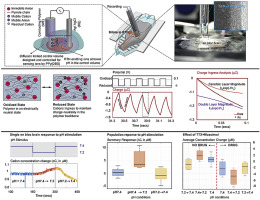当前位置:
X-MOL 学术
›
Biosens. Bioelectron.
›
论文详情
Our official English website, www.x-mol.net, welcomes your
feedback! (Note: you will need to create a separate account there.)
Near field non-invasive electrophysiology of retrotrapezoid nucleus using amperometric cation sensor.
Biosensors and Bioelectronics ( IF 10.7 ) Pub Date : 2019-12-18 , DOI: 10.1016/j.bios.2019.111975 Sujasha Gupta 1 , José Javier Otero 2 , Vishnu Baba Sundaresan 1 , Catherine Miriam Czeisler 3
Biosensors and Bioelectronics ( IF 10.7 ) Pub Date : 2019-12-18 , DOI: 10.1016/j.bios.2019.111975 Sujasha Gupta 1 , José Javier Otero 2 , Vishnu Baba Sundaresan 1 , Catherine Miriam Czeisler 3
Affiliation

|
Central chemoreception is the process whereby the brainstem senses blood gas levels and adjusts homeostatic functions such as breathing and cardiovascular tone accordingly. Rodent evidence suggests that the retrotrapezoid nucleus (RTN) is a master regulator of central chemoreception, in particular, through direct sensation of acidosis induced by CO2 levels. The oscillatory dynamics caused by pH changes as sensed by the RTN surface and its relationship to the fluctuations in cation flux is not clearly understood due to the current limitations of electrophysiology tools and this article presents our investigations to address this need. A cation selective sensor fabricated from polypyrrole doped with dodecyl benzenesulfonate (PPy (DBS)) is placed over RTN in an ex-vivo en bloc brain and changes in cation concentration in the diffusion limited region above the RTN is measured due to changes in externally imposed basal pH. The novelty of this technique lies in its feasibility to detect cation fluxes from the cells in the RTN region without having to access either sides of the cell membrane. Owing to the placement of the sensor in close proximity to the tissue, we refer to this technique as near-field electrophysiology. It is observed that lowering the pH in the physiological range (7.4-7.2) results in a significant increase in cation concentration in the vicinity of RTN with a median value of ~5 μM. The utilization of such quantifiable measurement techniques to detect sub-threshold brain activity may help provide a platform for future neural network architectures. Findings from this paper present a quantifiable, sensitive, and robust electrophysiology technique with minimal damage to the underlying tissue.
中文翻译:

使用安培型阳离子传感器对后梯形核进行近场无创电生理检查。
中枢化学感受是脑干感知血气水平并相应地调节诸如呼吸和心血管音调等稳态功能的过程。啮齿动物的证据表明,梯形后核(RTN)是中央化学感受的主要调节剂,尤其是通过直接感觉到由CO2水平引起的酸中毒。由于电生理工具的当前局限性,目前尚不清楚由RTN表面检测到的由pH变化引起的振荡动力学及其与阳离子通量波动的关系,本文提出了满足此需求的研究。将由掺杂有十二烷基苯磺酸盐(PPy(DBS))的聚吡咯制成的阳离子选择性传感器置于体外全脑中的RTN上方,并测量RTN上方扩散受限区域中的阳离子浓度变化,这是由于外部施加的变化引起的基础pH。该技术的新颖之处在于它可以检测RTN区域中细胞的阳离子通量,而不必进入细胞膜的两侧。由于传感器的位置非常靠近组织,因此我们将此技术称为近场电生理学。观察到,在生理范围(7.4-7.2)范围内降低pH值会导致RTN附近的阳离子浓度显着增加,中位值为〜5μM。利用这种可量化的测量技术来检测亚阈值以下的大脑活动可能有助于为未来的神经网络架构提供一个平台。本文的发现提出了一种可量化,灵敏且稳健的电生理技术,对基础组织的损害最小。
更新日期:2019-12-18
中文翻译:

使用安培型阳离子传感器对后梯形核进行近场无创电生理检查。
中枢化学感受是脑干感知血气水平并相应地调节诸如呼吸和心血管音调等稳态功能的过程。啮齿动物的证据表明,梯形后核(RTN)是中央化学感受的主要调节剂,尤其是通过直接感觉到由CO2水平引起的酸中毒。由于电生理工具的当前局限性,目前尚不清楚由RTN表面检测到的由pH变化引起的振荡动力学及其与阳离子通量波动的关系,本文提出了满足此需求的研究。将由掺杂有十二烷基苯磺酸盐(PPy(DBS))的聚吡咯制成的阳离子选择性传感器置于体外全脑中的RTN上方,并测量RTN上方扩散受限区域中的阳离子浓度变化,这是由于外部施加的变化引起的基础pH。该技术的新颖之处在于它可以检测RTN区域中细胞的阳离子通量,而不必进入细胞膜的两侧。由于传感器的位置非常靠近组织,因此我们将此技术称为近场电生理学。观察到,在生理范围(7.4-7.2)范围内降低pH值会导致RTN附近的阳离子浓度显着增加,中位值为〜5μM。利用这种可量化的测量技术来检测亚阈值以下的大脑活动可能有助于为未来的神经网络架构提供一个平台。本文的发现提出了一种可量化,灵敏且稳健的电生理技术,对基础组织的损害最小。











































 京公网安备 11010802027423号
京公网安备 11010802027423号